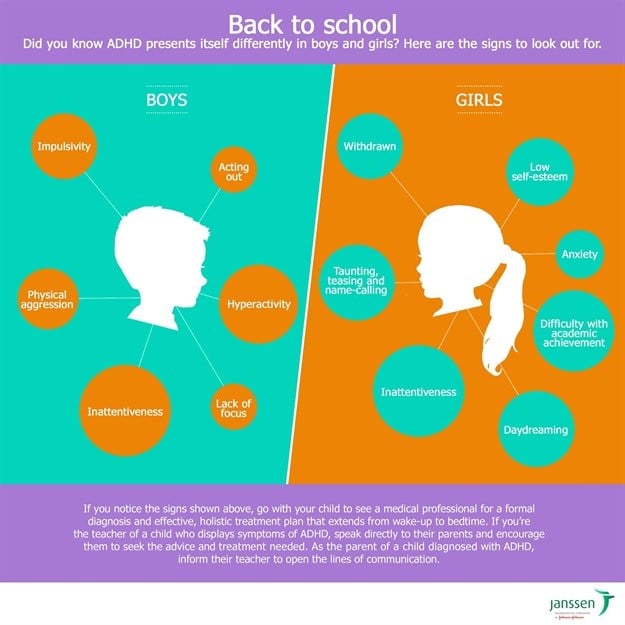
Without the correct diagnosis and treatment, ADHD can severely affect a child's ability to focus and, as a result, can lead to struggling with academics - and underperformance throughout a child's school career.
The knock-on effects of this underperformance can have a negative impact on the emotional and social well-being of your child, far beyond school hours, with lowered self-esteem and confidence issues.
Psychiatrist and convenor of the ADHD South African Special Interest Group, Dr Rykie Liebenberg, says teachers should be aware of the very different ways in which ADHD presents in the classroom.

"Most people don't know that boys and girls present in very different ways if they're struggling with ADHD, and there is often misdiagnosis as a result. Boys' symptoms are distinctly 'outward', whilst girls struggling with the disorder, in contrast, have more 'inward' symptoms."
"In a classroom situation, boys with ADHD may draw attention to themselves with rambunctious, uncontrolled behaviour, such as physical aggression, throwing things, jumping and running around. They can also show emotional dysregulation, with outbursts. In contrast, girls with ADHD may be withdrawn, prone to daydreaming and even chronically fatigued.
"The disruptive behaviour of a boy who might be struggling with ADHD makes it much easier for a teacher or parent to notice, and, hopefully correctly diagnose. Undiagnosed girls with ADHD are, in contrast, often quite well behaved - they just struggle to focus and remember what they're told."
One trait that can occur in both girls and boys with ADHD is hyper-focus. "A child struggling with undiagnosed ADHD will typically become fixated on one subject or item, to the exclusion of all their other school work."
Although the classroom is a key environment in which to identify the signs of ADHD, symptoms must present both at home and at school in order for a child to be diagnosed with ADHD. If a teacher suspects one of his/her pupils might be showing signs of undiagnosed ADHD, he or she should consult the child's parents immediately.
"The first step is to rule out other factors that could be having an effect on the child's behaviour at school. This might be a divorce, abuse or even an ill sibling." If, however, conditions at home are comparatively normal, and the child is showing similar signs of ADHD at home - inattention, hyperactivity and impulsivity - it is best for the parents to visit a medical professional to seek a formal diagnosis.
"ADHD left untreated can be crippling for a child trying to navigate an already new, intimidating school environment. Correctly managed, however, a child with ADHD can avoid unnecessary frustration, find focus in the classroom and reach his or her full potential," concludes Liebenberg.